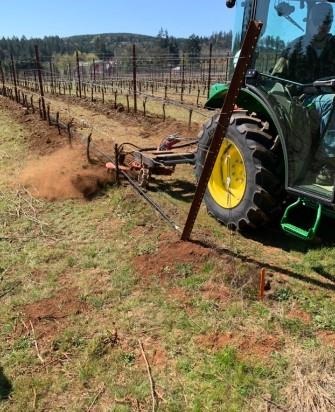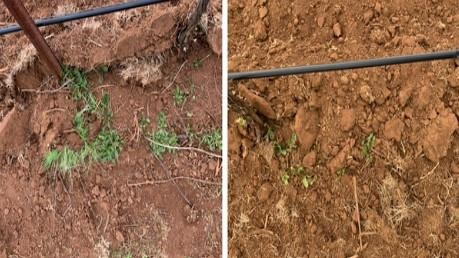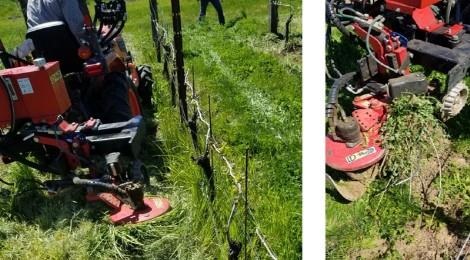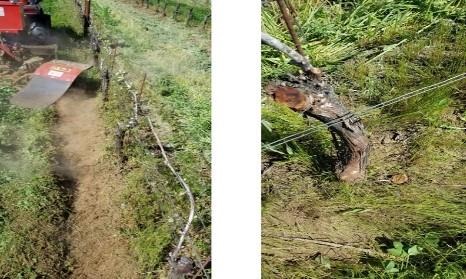By Marcelo Moretti and David King
Mechanical Weed Control under the Vine

Figure 1. On farm study evaluating under-vine cultivator in Turner, OR in the spring of 2021.
Vineyard floor management can be divided into two areas, the area under the vine and the area between the rows. Cover crops are often planted between the rows and mowed as needed during the season. Under the grapevines, a two- to four-foot strip is kept weed-free with herbicide applications. The most widely used herbicide in vineyards is glyphosate; it is cost-effective, controls many weed species, is environmentally friendly, and has low human toxicity[1]. However, there is a growing debate in the scientific community about glyphosate impacts on human health and reports of glyphosate and the presence of its metabolites in the food supply[2].
Mechanical cultivation is one option to replace or to complement chemical weed control under the vines. A variety of vineyard under-vine cultivators are available on the market. Weed control efficacy depends on plant species and operation timing, but no single piece of equipment will control all weed species or be compatible with all vineyard layouts. There is limited research in mechanical in under vine weed control options.
A project funded by Western Sustainable Agriculture Research and Education (WSARE, project number OW18-019) was initiated in 2018 to improve our understanding of the applications and limitations of under-trellis cultivators in Oregon vineyards. A total of six treatments were included: brush weeder, rotary tiller, hoeing blade, in-row mower, hoeing blade with rotary tiller, and a nontreated reference. Each side of the vine row was cultivated once with an ID David in row weeder with a single-side hydraulic articulating arm mounted on the rear of the tractor (Figure 1).
Among all implements, the best performance was observed when soil volumetric water content was below 30% in a silt clay soil. Rainfall, which occurred after cultivation, appeared to impact efficacy, as it supported weed regrowth or new seedlings. Cultivation early in the season was less effective in part because of significant rainfall in the weeks following the treatment. The highest level of control was observed with the hoeing blade with the rotary tiller. Control was as high as 80% four weeks after treatment. The tiller plus hoeing blade outperformed the hoeing blade alone in some instances, likely because this combination better disrupted weed root-soil contact (Figure 2).

Figure 2. Example of soil after treatment with hoeing blade (left) and hoeing blade with rotary tiller (right). The hoeing blade with rotary tiller treatment was more effective than the hoeing blade alone. The tiller effectively broke up the soil and reduced weed root-to-soil contact.
The rotary tiller alone did not control weeds as consistently as the hoe blade or the hoe blade with the tiller. The tiller operates in the top few inches of the soil, and not every plant was uprooted or cut during the operation. Also, it did not perform well in conditions with abundant plant biomass (Figure 3). That was also an issue with other implements when plant biomass, in this case a cover crop, blocked the sensor bar that controls the movement of the implement in and out of the planting row.

Figure 3. Excessive plant biomass blocking movement of the rotary tiller (left) and the sensor bar (right).
The mower could not be used early in the season because weeds were too short and could be mowed, but weeds might be tall enough to mow in late spring. Mowing can reduce weed biomass and potentially seed production. The brush weeder operates by cutting weeds at the soil level or by uprooting seedlings (Figure 4). This abrasive action produces minimal soil disturbance but can generate dust when the soil is dry. The benefit of the brush weeder is the control of weeds and removal of grape suckers in one pass. We did, however, observe the brush weeder removing the bark of some vines. Further, it would become entangled with trellis wires placed closer to the ground. Weed control varied among sites, but in general, the brush weeder suppressed weed regrowth, unlike the mower.

Figure 4. Brush weeder in operation in a vineyard in Yamhill, OR 2019 (left). The brush was spinning at 1,500 rpm, cut plants at the soil level, and uprooted smaller seedlings. The abrasive action can remove bark (right), generate dust, and entangle with wire installed too closely to to the ground.
Source : ucanr.edu